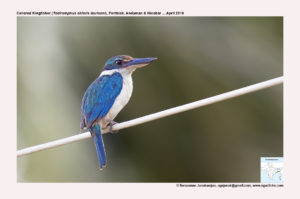Collared Kingfisher

Collared Kingfisher Todiramphus chloris
Etymology:
- Todiramphus : French name for chattering Kingfisher, genus Todus – tody; Greek word rhamphos- bill
- Chloris : Latin word for Green derived from khloros- green
Vernacular Names: Mal: Kayal ponman, Hindi: Dakshini Kilkila, Mar: Kantheri Dhivar
Distribution in India: Resident of Andaman & Nicobar Island, parts of West coast and East coast of India.
Description: Size of 23–25 cm; male wt. is 51–90 g, female wt. is 54–100 g. It is a medium-sized kingfisher with variable plumage pattern. The male of nominate race has white supraloral spot, black mask extending in narrow band across hindneck, white collar, greenish-blue crown and upperparts, brighter blue rump, blue wings and tail, white underparts. The upper mandible is grey-black, lower mandible is yellowish-horn with dark brown cutting edges and tip; iris is dark brown; legs and feet are dark grey, soles are yellowish. The female is duller. The juvenile is duller, greener above and buffier below, neck and breast feathers are fringed with dark grey, upperwing-coverts tipped with buff. It is found in mangroves on the coast and in tidal creeks.
Habitat: It is found from sea-level up to 1500 m.
Food habits: When on coast it eats crustaceans such as shrimps and crabs ,small fish, mudskippers . Those away from coast eat insects like cicadas beetle), carpenter-bee) and wasps, grasshoppers), stick-insects, butterflies and moths spiders, earthworms, snails, land crabs, frogs, lizards and snakes . It perches for long periods, with little activity, swoops down to take prey from the ground, mud or shallow water and returns with it to perch, where prey is battered before being eaten. Also takes prey from ground without landing, and snatches insects in mid-air; also surface-plunges into shallow water, sometimes after brief hover. It probes into mud for prey on exposed tidal flats. It follows smooth-coated otters to catch fish disturbed by the mammals.
Breeding habits: They breed in Apr–Jul in Ethiopia, in Jun in United Arab Emirates; in Apr–May in North East India and Bangladesh, in Mar–May in Andaman Is, in Feb–Mar in Nicobar Is, in Apr in Myanmar, in Mar–Jul in Thailand, in Dec–Aug in Peninsular Malaysia, in Mar–Nov on Sumatra and Java, and in May–Jun in Borneo and Philippines; in Jul–Aug in Marianas, in Oct–Mar in New Guinea, in Aug–Nov in Solomons, in Oct in Vanuatu, in Dec in Fiji, and in Sept–Feb in Australia. They have two broods in each season. They breed as solitary pairs. The breeding rituals include mutual chases low over trees in courtship-flights, and male courtship-feeds female prior to mating; mates spread wings in greeting. The nest is excavated in arboreal termitarium, in rotten tree trunk or stump, in earth bank, in soil around roots of upturned tree, or in base of bird’s-nest fern, or a natural hole in tree or one made by woodpeckers is used. Both birds fly at the site and strike it with the bill, later cling to rim while digging with bill and using feet to remove debris. They lay a clutch of 2–5 eggs. Both parents feed the young. The fledgling period is 29–30 days.